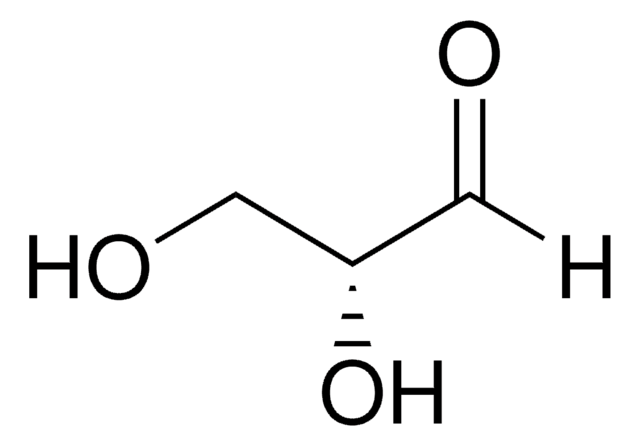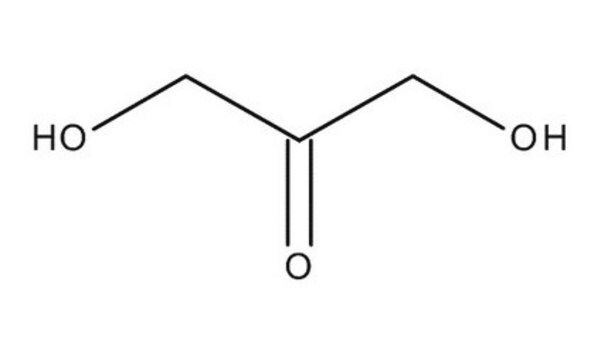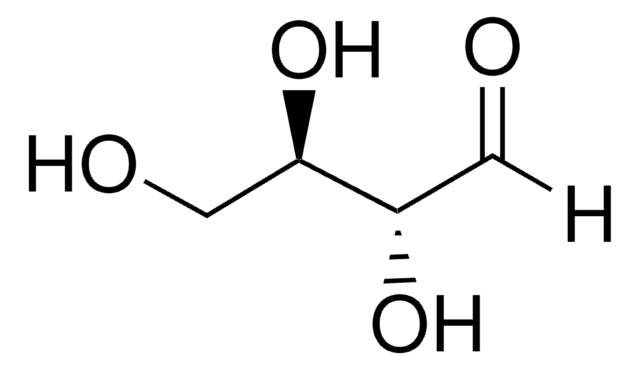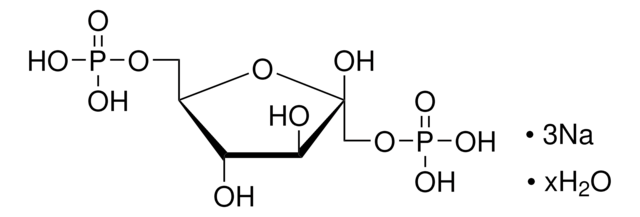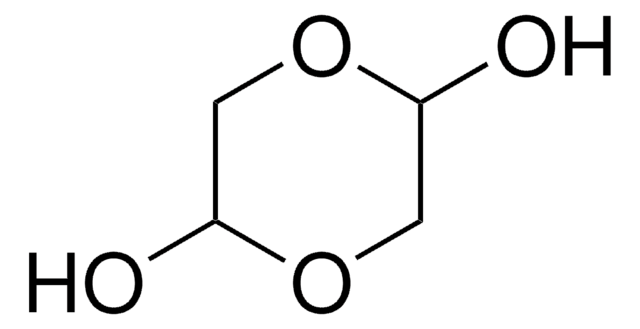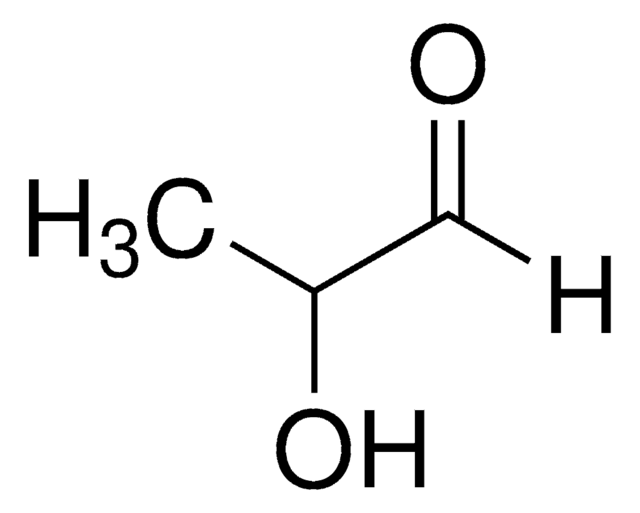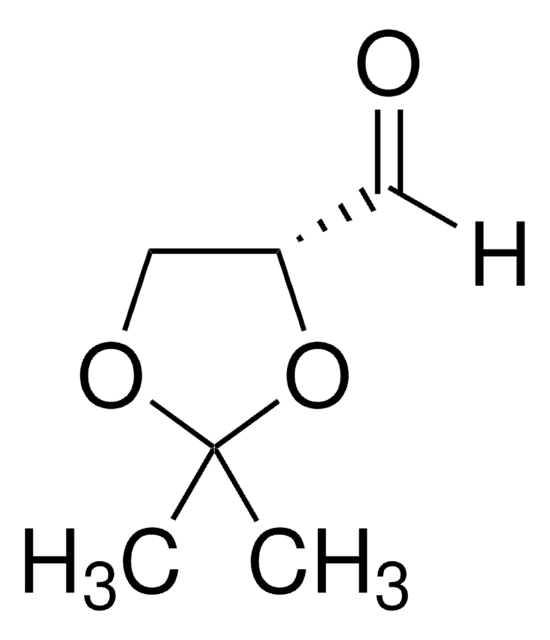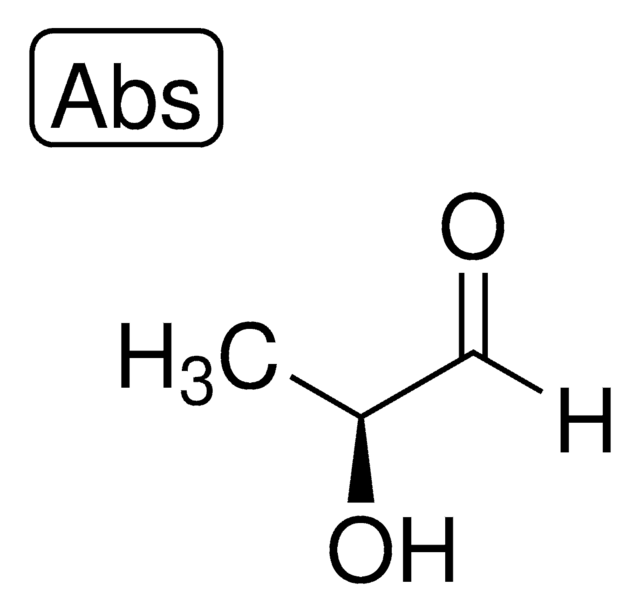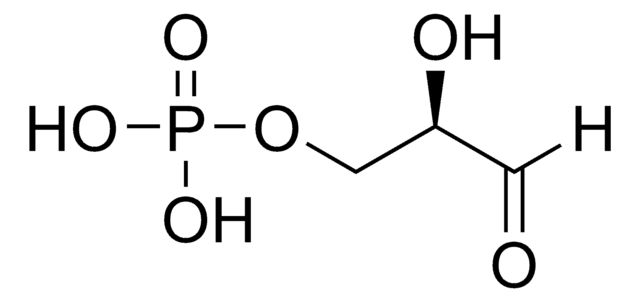73572
L-(−)-Glyceraldehyde
≥90% (HPLC)
Sinônimo(s):
(2S)-2,3-Dihydroxypropanal
Faça loginpara ver os preços organizacionais e de contrato
About This Item
Fórmula empírica (Notação de Hill):
C3H6O3
Número CAS:
Peso molecular:
90.08
Beilstein:
1720475
Número CE:
Número MDL:
Código UNSPSC:
12352204
ID de substância PubChem:
NACRES:
NA.32
Produtos recomendados
Ensaio
≥90% (HPLC)
atividade óptica
[α]/D -11.0±3.0°, c = 2 in H2O (after 24 h)
solubilidade
water: soluble 30 g/L at 18 °C
temperatura de armazenamento
2-8°C
cadeia de caracteres SMILES
OC[C@H](O)C=O
InChI
1S/C3H6O3/c4-1-3(6)2-5/h1,3,5-6H,2H2/t3-/m1/s1
chave InChI
MNQZXJOMYWMBOU-GSVOUGTGSA-N
Procurando produtos similares? Visita Guia de comparação de produtos
Aplicação
- L-Glyceraldehyde Inhibits Neuroblastoma Cell Growth via a Multi-Modal Mechanism on Metabolism and Signaling.: This research highlights the inhibitory effects of L-Glyceraldehyde on neuroblastoma cell growth, revealing its impact through multiple pathways in metabolism and cell signaling (Forbes M et al., 2024).
Ações bioquímicas/fisiológicas
L-(-)-Glyceraldehyde is an important intermediate in carbohydrate metabolism.
Embalagem
Bottomless glass bottle. Contents are inside inserted fused cone.
Outras notas
To gain a comprehensive understanding of our extensive range of Monosaccharides for your research, we encourage you to visit our Carbohydrates Category page.
Código de classe de armazenamento
10 - Combustible liquids
Classe de risco de água (WGK)
WGK 3
Ponto de fulgor (°F)
233.6 °F - closed cup
Ponto de fulgor (°C)
112 °C - closed cup
Escolha uma das versões mais recentes:
Já possui este produto?
Encontre a documentação dos produtos que você adquiriu recentemente na biblioteca de documentos.
Os clientes também visualizaram
David A Korasick et al.
Journal of molecular biology, 431(3), 576-592 (2018-12-24)
Heterokonts, Alveolata protists, green algae from Charophyta and Chlorophyta divisions, and all Embryophyta plants possess an aldehyde dehydrogenase (ALDH) gene named ALDH12. Here, we provide a biochemical characterization of two ALDH12 family members from the lower plant Physcomitrella patens and
Nina Richter et al.
Biotechnology and bioengineering, 106(4), 541-552 (2010-03-04)
A whole-cell catalyst using Escherichia coli BL21(DE3) as a host, co-expressing glycerol dehydrogenase (GlyDH) from Gluconobacter oxydans and glucose dehydrogenase (GDH) from Bacillus subtilis for cofactor regeneration, has been successfully constructed and used for the reduction of aliphatic aldehydes, such
Cancer biomarker AKR1B10 and carbonyl metabolism.
Balendiran, G. K., et al.
Chemistry & Biology, 178, 134-137 (2009)
Nina Richter et al.
Chembiochem : a European journal of chemical biology, 10(11), 1888-1896 (2009-07-07)
The acetic acid bacterium Gluconobacter oxydans has a high potential for oxidoreductases with a variety of different catalytic abilities. One putative oxidoreductase gene codes for an enzyme with a high similarity to the NADP+-dependent glycerol dehydrogenase (GlyDH) from Hypocrea jecorina.
Takanori Matsui et al.
Cardiovascular diabetology, 14, 1-1 (2015-01-15)
We have previously shown that serum levels of glyceraldehyde-derived advanced glycation end products (Gly-AGEs) are elevated under oxidative stress and/or diabetic conditions and associated with insulin resistance, endothelial dysfunction and vascular inflammation in humans. Further, Gly-AGEs not only evoke oxidative
Nossa equipe de cientistas tem experiência em todas as áreas de pesquisa, incluindo Life Sciences, ciência de materiais, síntese química, cromatografia, química analítica e muitas outras.
Entre em contato com a assistência técnica